“End Times” Anthropology: Lessons from the Pantaron Manobo
Myfel Paluga reflects on what the Pantaron Manobo’s tradition of neighbour-distancing may teach us about valuing old and new modes of living in light of the Covid-19 pandemic.
Usable skills
I remember being very bored in a class taught by the pioneering Filipino anthropologist Prospero Covar. It was 1999 and he was giving a lecture on prehistoric technologies, which sounded like a monotonous list of inventories. Yet somewhere between Acheulean and Austronesian tools Covar made a very brief remark that has stuck with me ever since: “What I am telling you here should not be museum-knowledge only. At least a few individuals on this earth should take it as their task to continue mastering these technologies and pass them on. When extreme calamities occur, especially of apocalyptic magnitude, humans can always fall back on these time-tested means of survival.” It sounded like a joke, but Covar was never known to be the joking type.
This remark thoroughly changed my perspective on “old” practices that appear to be rapidly becoming obsolete in the twenty-first century. If at that point I still had any lingering, perhaps exoticizing, curiosity for such practices, this was now replaced by the question of how these may remain usable skills for the present and future. Covar’s words immunized me, to some extent, from being always only fascinated with what is new and at the same time they have attuned me to what practices and objects around me represented elemental and durable ways of living. For example, a few years ago I was involved in a study on starch-producing sago palms in Mindanao and the Central Philippines and up until today whenever I see a palm, even in urban settings, I mentally calculate how much flour it could produce, and (based upon the tips and tricks of my interlocutors) what tools and techniques would be best for growing and harvesting that particular species in case of an “end time” event.
Of course I knew that places vary in affordances and facilities which, in unfortunate situations, can render such skills useless. But I simply decided to temporarily deny this and focus on such happy ideas as modularity and adaptability. It was in another fieldwork setting, years later, that this irreducible disjoint between one’s habitual ways vis-à-vis the materiality of spaces and situations became impossible to ignore.
Long fingernails
My wife, Andrea, and I were doing fieldwork among the Pantaron Manobo. One of her closest interlocutors was Sumila, the feisty wife of a village chieftain. She often asked as many questions to my wife as Andrea did to her. One day Sumila asked: “What is this that I hear from the medical committee, that if your nails are long and you eat with your hands, that is where that thing that makes you sick comes from?” She spoke briskly and did not let the language barrier stop her. Her son Mas looked at my wife sheepishly as he translated his mother’s query, while her daughter Christine chuckled beside her. Mas, by the way, was himself a member of the medical committee.
Sumila did not wait for an answer, but cried out, “I don’t believe it! Back in the Pantaron we had the same hands and no one got sick. But here, even if you clean your hands, you still get sick.” “Here” was the evacuation center in Tagum City where Sumila, her family, and one hundred other Pantaron Manobo, had been living for about a year by the time we arrived for fieldwork in late 2018, after they had been displaced by military operations.
Sumila and her community of lumad (indigenous peoples) are from the Pantaron Mountain Range in southern Mindanao. At the moment they are in their evacuation center, on lockdown, like almost everyone else in the Philippines.
Neighbour-distancing
The Covid-19 pandemic has cast a different light on how I view the Pantaron’s mode of living, shaped by historic moves to resist (or cut ties with) colonial and lowland “development.” They used to live in well-distanced “big houses”, as recalled by older generations. Nowadays they live in house-clusters, about an hour of walk away from each other. Over time, they have developed mobile ways that help them put distance between themselves and perceived sources of harm, and this has resulted in dispersed settlement patterns, frequent moves of houses and villages when a village-mate dies, and new pathways on the mountain ranges to avoid areas deemed unhealthy. In what contrast to stereotypes of the indigenous peoples as always in a communal mode of living, the Pantaron Manobo are appreciative of personal differences and think highly of having a robust sense of individual personality. At the same time, such neighbour-distancing invokes openness, as they tend to form rhizomatic links across houses and villages—and even welcome “strangers”—in the interest of political coordination and acquisition of new knowledge when this is deemed necessary.
Their way of life was strongly on my mind as I reflected on the present needs to reinvent and forge new cultural, perhaps even civilizational, habitus, institutions, and life orientations, responsive to the present paradigm of “social distancing.” I now wonder if highland Pantaron Manobos may give us a perspective of a viable socio-ecological logic of living, one that is flexibly responsive to our “End Times”.
This blog post is part of a research that has received funding from the University of the Philippines System's Faculty, REPS and Administrative Staff Development Program (FRASDP) and also from the "Bodies and Images: The development and persistence of Pantaron Manobo tattooing" project, with AM Ragragio as the principal investigator, funded by the National Geographic Society (Grant Number EC-KOR-45049R-18).



0 Comments
Add a comment